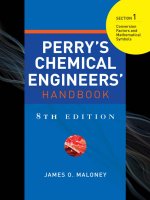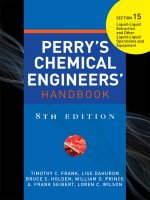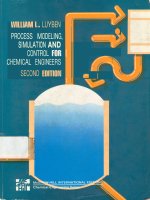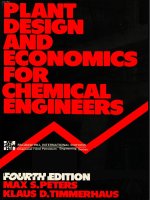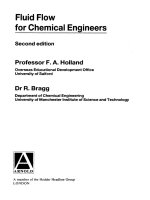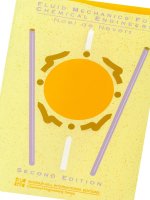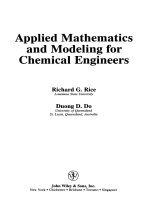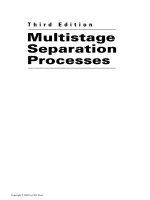Course material chemical engineering for non chemical engineers 5days module
Bạn đang xem bản rút gọn của tài liệu. Xem và tải ngay bản đầy đủ của tài liệu tại đây (20.86 MB, 174 trang )
Course Material
Chemical Engineering for Non-Chemical
Engineers – 5 Days Module
Index
Sr. No.
1.
2.
3.
4.
5.
6.
7.
8.
9.
10.
11.
12.
13.
Content
Introduction to workshop and DDU
Unit Operations
Chemical Process Calculations
Fluid Flow Operation
Mechanical Operation
Agitation and Mixing
Heat Transfer
Mass Transfer Operations-Distillation
Mass Transfer Operations-Absorption
Mass Transfer Operations-Drying
Chemical Reaction Engineering
Instrumentation Process Control
Mass Transfer Operation - Adsorption
Introduction to workshop and DDU
DHARMSINH DESAI UNIVERSITY
Dharmsinh Desai Foundation was established at Nadiad in Gujarat, by an eminent Parliamentarian
and a social worker, Late ShriDharmsinh Desai to develop institutions that would improve the
quality of life for the people in and around Nadiad. It has schools, colleges, public library and
hospitals under its umbrella. The DD Foundation started Dharmsinh Desai Institute of Technology
(DDIT) an affiliated college in 1968, offering Degree and Diploma in Chemical Engineering, has
now becomeDharmsinh Desai University (DDU), a trusted name amongst a variety of stake holders,
namely, students, their parents, researchers, academicians, employers, other academic institutions
offering higher level education, National level Institutions and State & Central Government agencies.
The key milestones it has crossed in the past 40 plus years of its existence are addition of Degree
courses in Civil Engineering (1981), Electronics and Communication Engineering (1981), Computer
Engineering (1985), Instrumentation & Control Engineering (1985), and Information Technology
(1999). Further it also added undergraduate programs in Commerce (B.Com in 1980 under
Dharmsinh Desai Institute of Commerce), Computer (BCA, 1999), Management (BBA, 1999),
Dental Sciences (2005), and Pharmacy (2006). It also added Post Graduate level programs like M.E
in Chemical Engineering (1981), M.E in Electronics & Communication (1986), M.E in Civil
Engineering (1986), MCA (1987), MBA (1994), M.E in Instrumentation & Control Engineering
(2002), and M.E in Computer Engineering (2002). Doctoral level programs in
Engineering/Technology, Management, Pharmacy, Physical Sciences and Social Science were
initiated in 2001. DDU has added Master’s Program in Dental Sciences, Master’s Program in
Pharmacy and also in the process of adding an undergraduate program in Medical Sciences leading
to MBBS, in the coming years. DDU (erstwhile DDIT) became the first Autonomous Institute in
Gujarat State. Later, in the year of 2000, it was awarded a status of ‘Deemed University’ by
Government of India, in recognition of its commendable standards in Academia. In April 2005, the
Government of Gujarat declared this Institute as a ‘State University’.DDU has ISO 9001:2008
certification since past eight years.
DDU’s Vision is to become a multi-disciplined & ‘learner oriented’ university to closely associate
with & be responsive to the Industry, to create supportive & caring environment for staff & students
and to engage in R & D activities in areas of national priority.DDU’s Mission is to undertake
programs and projects for development of human resources, both through formal and non formal
delivery systems, in areas of professional pursuits in all walks of human endeavors, with accent on
relevance, value addition, societal needs and futuristic pilot projects.
DDU has recently established The Shah-Schulman Centre for Surface Science and Nanotechnology
with the help of a grant of Rs. 3.5 crores from Government of Gujarat. This Centre is headed by a
world known scientist, Dr. Dinesh Shah of University of Florida, whohas to has credit 7 books, 6
patents, and has over 250 research papers in referred journals, monographs and books. Dr. Shah has
been invited to more than fifty corporate research centers and has presented over 200 seminars at
Corporate Research and Development Centers during the past 40 years. He has provided consulting
services to the some of the world’s best managed corporations on a long-term basis (i.e. several
years). This Centre is one of its kinds in the country and is doing pioneering work in association with
the Industries and Academia. There are nine corporate members who have pledged Rs. 15 lacs each –
totaling to Rs. 1.35 crores for the development of above Centre.
DDU has a very strong Alumni Association (DDU Alumni Association – DDUAA) formerly, DDIT
Alumni Association (DDITAA) and it was established in August, 1993, with its headquarters at the
DDU having chapters at Ahmedabad, Ankleshwar and Baroda. It has membership strength of about
4310. The association is proud of its members, as most of them have excelled in their respective
Anchor Institute: Chemicals and Petrochemicals, DDU, Nadiad
Page 1
Introduction to workshop and DDU
fields. Many of them have won coveted awards and more than 1000 members are settled abroad. The
association has been promoting interaction among industries, ex-students and the university to
enhance the cause of technical education. DDUAA has organized and conducted more than 25
seminars, lectures and workshops at various places like Ahmedabad, Baroda, Ankleshwar and
Nadiad.
FACULTY OF TECHNOLOGY
The Faculty of Technology (FoT) offers 7 undergraduate programs and 10 post graduate programs in
engineering. It is noteworthy that Faculty of Technology is the only grant-in-aid institution in the
state to receive World Bank Assistance of Rs.7.8 crores. The NBA-AICTE has also granted
Accreditation to the B.E. courses of the Faculty. It also has linked up with the University of IOWA,
USA to offer a five year joint B.E+M.S. program where a student goes to University of IOWA for
two years – after completing three years at the DDU. The feedback from the University of IOWA is
very encouraging and they have given tuition waivers and research grants to our students as they find
them very deserving. Through another Memorandum of Understanding with KHS Germany, the final
semester engineering students undertake their four months long Industry Project at KHS in Germany
and all their expenses are met by the company there and they are also absorbed by their various
companies all over the world.
All the students of faculty of technology undertake the full time Industry based project training in
their final semester of the program which enables them for employment through campus interviews
much before course completion.
FoT has a R&D Centre since 1998 and its main objective is to carry out research activity in the area
of Information Technology, Computer Science, Computer Application and Electronics &
Communication with the respective faculty members. R & D Center is also giving training to final
semester students of the respective discipline to carry out the project in the area of cutting edge
technology. It has taken up national level projects from pioneer institutes like National Crime Record
Bureau, Institute of Plasma Research, Oil and Natural Gas Corporation Limited, HiRel Reliance
Limited, GujartSamachar, Muljibhai Patel Urology Hospital, Forensic Laboratory and many others.
It has the distinction of developing a Portrait Building System which is successfully used at every
District Police Head Quarters in the Country to arrest criminals. It was first field tested in Rajiv
Gandhi Assassination case by National Crime Record Bureau.
Training & Placement is vital for any Educational Institute and DDU has a good track record in this
area. INFOSYS has played a key role in this area. We have a large number of repeat companies in
campus placements and this indicates their faith in the ability of our students. All the visiting
companies have said it time and again that the teaching learning processes at the DDU are the second
to none.
DEPARTMENT OF CHEMICAL ENGINEERING
The Department of Chemical Engineering, established in the year 1968 along with the inception of
the college, is one of the oldest Chemical Engineering Departments in Gujarat. Since then it has
made remarkable contributions in the field of Chemical Engineering and its alumni has occupied
eminent positions in the industry, academic and research institutions in India as well as abroad. The
first batch of Engineers came out in 1973. In 1983, the roots of Chemical Engineering Department
became even stronger with the introduction of Post Graduate Program. In addition to this, department
Anchor Institute: Chemicals and Petrochemicals, DDU, Nadiad
Page 2
Introduction to workshop and DDU
has achieved remarkable milestone of NBA accreditation of five years for both PG and UG program
in 1998 due to its best performance at all stages and currently has 5-year NBA accreditation for the
UG program (2008-2013).
Because of its excellent infrastructure, with reference to classrooms, laboratories and pilot plant
equipment to help in research and development, the department has made a name for itself in the
industrial sector. The curriculum of Chemical Engineering is continuously being modified and
upgraded in accordance with the industrial requirements.
The IPCL library at the institute possesses a good collection of Chemical Engineering books,
journals and periodicals which enables the students to keep track of the latest technological
developments. This in turn has given a great impetus to them, hence leading to higher academic
involvement. The support has further encouraged students to undergo rigorous work in the field of
research.
FACILITIES IN THE DEPARTMENT
The Department of Chemical Engineering at DDU has a well maintained computer laboratory to aid
student’s in their work. The department is one of the few institutes to possess two Sun Workstations
along with advance simulation software such as ASPEN PLUS®, MATLAB®, GAMS, Gambit and
HTRI. These softwares are used to design and simulate various processes and process equipments
like scrubbers, distillation columns, absorbers, reactors & heat exchangers apart from property
estimation. MATLAB®, with its toolboxes like Artificial Neural Networks, Optimization, Simulink,
Fuzzy Logic etc., is much needed kit for research. Department also has post graduate simulation
laboratory with 20 computers, 2 printers and servers.
The Department has well equipped state of art laboratories; viz. Fluid Flow Operations Lab, Heat
Transfer Laboratory, Mechanical Operation Laboratory, Mass Transfer Lab, Process Control Lab,
Chemical Reaction Engineering and Transport Phenomena laboratory.Several pilot scale equipments
such as vacuum distillation column, extraction column, tray driers, centrifuges, glass lined reactor,
SS reactor, thickener, cyclone separator are available.
Advanced Instrumentation laboratory is also a well-equipped with latest advanced instruments to
boost the research conducted by PG and PhD students of department. The laboratory is facilitated
with instruments like HPLC, GC, FTIR, BET surface area analyzer, TOC, Spectro-fluorometer, UVVIS Spectrophotometer, Contact Angle, Atomic absorption spectrophotometer.This laboratory also
possesses pH meters, turbidity meters, T.D.S measuring devices, and COD and BOD testing
equipment for the primary and secondary analysis of industrial effluents. The laboratory also has
equipment for Gas Chromatography and UV Spectrophotometer.
With Biotechnology slowly gaining importance, the Biotechnology Laboratory at DDIT offers
research facilities like autoclave, automatic computer controlled biofermenter with pH, temperature,
and Dissolved oxygen controllers, and incubator, centrifuge, sterilizer, Tissue culture hood, Jar
shaker, colony counter, electronic microscope, etc.
RESEARCH & DEVELOPMENT
The faculty members because of their high academic qualifications from reputed Institutions
have a great potential for advanced research and development programs. This was the reason
for the introduction of M.E program as early as 1982. Quality projects have been carried out
Anchor Institute: Chemicals and Petrochemicals, DDU, Nadiad
Page 3
Introduction to workshop and DDU
at the M.E. level by the students with good guidance from faculty members. Many of the
projects have got awards and have received acceptance in the industry. Thrust areas of the
research for the department are Surface Science & Nanotechnology, Catalysis, Computeraided Design & Control, Pollution prevention through process modifications.
This department has produced two award winning M.Tech. thesis titled ” Steady State
Multiplicity of Hydrolysis of Acetic Anhydride in CSTR in Series ” and ” Heat Transfer
Studies in Half Coiled Jacket ” under the able guidance of Dr.N.S.Jayakumar.
GRANTS AND FUNDING
Department has got grants and funding from various sources as under
The Government of Gujarat has given a grant of Rs. 3.5 crores to establish the ShahSchulman Centre for Surface Science and Nanotechnology at DDU. March 2009.
The Council for Science and Technology (GUJCOST) has declared the Department of
Chemical Engineering as a Centre of Excellence and given a grant of Rs. 28.5 lakhs for
research on nanocatalysis – development and applications, to Prof. P.A. Joshi, Professor of
Chemical Engineering, DDU. (April 2009)
The Industries Commissionerate, Government of Gujarat has given a grant of Rs. 10-crore to
DDU and naming it as Anchor Institute to provide manpower training programs in the
Chemical & Petrochemical Sector for the state of Gujarat. This is a four year project which
has commenced from August 2009.
The Department of Science and Technology (DST), New Delhi, has chosen Dr. Manish
Mishra, of the Department of Chemistry and Chemical Engineering (and Shah-Schulman
Centre for Surface Science and Nanotechnology) for the Young Scientist Fast-Track Scheme
and will be funding his research (about Rs 21lakh) proposal on acid catalysts. April 2010
The GSFC Science Foundation has funded the project on ”Nanotechnology to Clean Water in
Developing Nations: Poor Man’s Filter” submitted by Dr. Premal R. Shukla , Professor &
Head, Department of Chemical Engineering (and Shah-Schulman Centre for Surface Science
& Nanotechnology), DDU for a period of three years for Rs. 10.27 lakhs.
Ministry of Human Resources Development, Government of India, has sanctioned
Community Development Polytechnic to us with an outlay of Rs 71 lakh over a period of 5
years commencing from April 2010.
University Grant Commission, New Delhi, has sanctioned M Tech (ChemEngg) program to
Dept of Chem. Engg. with specialization in Surface Science & Nanotechnology with a total
budget of Rs 41.5 lakh which will commence from July 2010.
PG PROGRAM
The department has M.TechProgram in Chemical Engineering with a intake of 18 students
specializing in Computer Aided Design and Environmental Engineering. A UGC supported M Tech
program in Chemical Engineering with specialization in Surface Science & Nanotechnology is being
offered from 2010. Seven students are pursuing their PhD from the department.
INDUSTRY INSTITUTE INTERACTION
One of the remarkable features after autonomy is that the students have to undergo training / project
work in industry as partial fulfillment of the degree. The training period extends to 16 weeks. During
this time, the students get an opportunity to learn about the practical aspects of Chemical
Engineering. The faculty members regularly visit the industry to raise and maintain high standard of
Anchor Institute: Chemicals and Petrochemicals, DDU, Nadiad
Page 4
Introduction to workshop and DDU
education through interaction. Campus recruitment takes place every year by reputed industries like
Reliance Industries Ltd., GSFC, GNFC, GACL, United Phosphorus Ltd., Tata Chemicals, GHCL,
etc as well as the telecom giant MBT. A GSFC Science Foundation Chair has been established in our
institute. Every year, this chair is awarded to an outstanding Chemical Engineer of international
repute. In 1996, a new separate building for library was built with a generous donation from IPCL.
The Institute conducts workshops and seminars for the benefit of industrial personnel. It is good
example of industry-institute relationship
Environmental audit cell conducts environmental audit in 41 process industries in state of Gujarat
under Gujarat Pollution Control Board and doing consulting activity up to Rs 80 Lakhs per year as a
result of good Industry Institute Interaction activity. In addition to this, several industries come
forward to solve their technical problems, process modifications and get clearance certificates from
the departmental faculty. Industrial experts are also invited to deliver lectures, conduct practical
exams, vivas and give their input on course curricula and syllabus.
ANCHOR INSTITUTE-CHEMICALS & PETROCHEMICALS
THE INDUSTRIES & MINES DEPARTMENT, GOVERNMENT OF GUJARATentrusted
DHARMSINH DESAI UNIVERSITY to take up the challenge to be an ANCHOR INSTITUTE
(AI) for the fastest growing Chemicals & Petrochemicals sector of the state. Its Partners are L. D.
College of Engineering, Ahmedabad as Co Anchor Institute, N. G. Patel Polytechnic, Afwa, Bardoli
and ITI Ankleshwar as Nodal Institutes. The Anchor Institute has become functional from July,
2009 under Department of Chemical Engineering, FoT.
OBJECTIVES:
The objective of the Anchor Institute and its partners is to take various initiatives in creating readily
employable and industry responsive Man Power, at all level for Chemicals & Petrochemicals across
the State and can be summarized as under:
Identifying the training courses and skill development programs as per the need of the
industries in Gujarat state for people in the industries and unemployed persons who are seeking
jobs in this sector
Identifying and conducting the training courses and skill development programs and
preparation of their course materials as per the need of the industries in Gujarat state for SUCs,
ITI, Diploma & Degree Level faculty members and students.
Organizing faculty development programs (training for trainers) for conducting these training
courses through the Nodal Institutes.
Mentoring and Assisting the Nodal Institutes to run training courses.
Benchmarking of these training courses.
Up grading the Courses offered in Chemical & Petrochemical Engineering and make them
Industry responsive.
Identifying new and emerging area in this field and undertaking research activities to keep pace
with global development.
THE TARGETED BENEFICIARIES:
Unemployed technical manpower having completed the formal study
Technical manpower already in job by up gradation of skills
Faculty members of the technical institutions
Anchor Institute: Chemicals and Petrochemicals, DDU, Nadiad
Page 5
Introduction to workshop and DDU
Students of Technical Institutions
The Anchor Institute has conducted 41 training programs wherein training of 9020 man days has
been imparted to total of 2281 persons. This includes 1123 students, 442 faculty and 716 industry
personnel. The training covered a variety of courses; some of them are on software, repair and
maintenance, plant operation, safety and environment, etc. The details about the Anchor Institute is
available on
Anchor Institute: Chemicals and Petrochemicals, DDU, Nadiad
Page 6
Vimal Gandhi
Unit Operations
Introduction
In chemical engineering and related fields, a unit operation is a basic step in a process. The different
chemical industries were regarded as different industrial processes and with different principles.
Arthur Dehon Little proposed the concept of "unit operations" to explain industrial chemistry
processes in 1916. In 1923, William H.Walker, Warren K. Lewis and William H. McAdams wrote
the book The Principles of Chemical Engineering and explained the variety of chemical industries
have processes which follow the same physical laws. They summed-up these similar processes into
unit operations. Each unit operation follows the same physical laws and may be used in all chemical
industries. The unit operations form the fundamental principles of chemical engineering. The study
of unit operations provides a unifying and powerful basis for an understanding of the different
chemical process industries. Chemical engineering unit operations consist of mainly following
classes:
Fluid flow operations - fluids transportation and solids fluidization
Heat transfer operations - evaporation and condensation
Mass transfer operations - gas absorption, distillation, extraction, adsorption, drying,
crystallization, humidification
Mechanical operations - solids transportation, crushing and pulverization, screening and
sieving, filtration
Fluid Flow Operations
The flow of fluid is important in many of the unit operations of chemical engineering. The handling
of liquids is much simpler, cheaper and less troublesome than handling solids. Consequently, the
chemical engineer handles everything in the form of liquids, solutions, or suspensions wherever
possible; and it is only when these methods fails that he resorts to the handling of solids. Even then,
in many operations a solid is handled in a finely subdivided state so that it stays in suspension in a
fluid. Such two-phase mixtures behave in many respects like fluids and known as “fluidized” solids.
The fluid may be defined as a substance that does not permanently resist distortion. An attempt to
change the shape of a mass of fluid will result in layers of fluid sliding over one another until a new
shape is attained. During the change in shape, shear stresses will exist, the magnitude of which
Anchor Institute: Chemicals and Petrochemicals, DDU, Nadiad
Page 1
Vimal Gandhi
Unit Operations
depends upon the viscosity of the fluid and the rate of sliding, but when a final shape is reached, and
all shear stresses will have disappeared. A fluid term is used to include both liquid and gases.
At any given temperature, a fluid having a definite density (ρ), which is measured in mass per unit
volume (kg/m3). Although the density of a fluid depends on both temperature and pressure, in the
case of liquids the density is not appreciably affected by moderate changes in pressure. In the case of
gases, density is affected appreciably by both temperature and pressure. If the fluid is inappreciably
affected by changes in pressure, it is said to be incompressible. Most liquids are incompressible. The
density of liquid can, however, change considerably if there are extreme changes in temperature.
Measurement of fluids: Since the materials used in industrial processes are in the form of liquids or
solutions wherever possible, it becomes of prime importance to be able to measure the rate at which
a fluid is flowing through a pipe or other channel. Methods of measuring fluids may be classified as
follows:
(i)
Direct weighing or measuring
(ii)
Hydrodynamic methods
a. Orifice
b. Venturi meter
c. Pitot tube
d. Weirs
e. Rotameter
(iii)
Direct displacement
a. Disc meters
b. Current meters
(iv)
Miscellaneous : dilution methods
Pumping of fluids:
For the pumping of fluids from one vessel to another or through long pipes, some form of
mechanical pump is usually used. The energy required by the pump will depend on the height
through which the fluid is raised, the pressure required at delivery point, the length and diameter of
the pipe, the rate of flow, together with the physical properties of the fluid, particularly its viscosity
and density. The pumping of liquids such as sulphuric acid or petroleum products from bulk store to
Anchor Institute: Chemicals and Petrochemicals, DDU, Nadiad
Page 2
Vimal Gandhi
Unit Operations
process buildings, or the pumping of fluids round reaction units and through heat exchangers, are
typical illustrations of the use of pumps in the process industries. On the one hand, it may be
necessary to inject reactants or catalyst into a reactor at a low, but accurately controlled rate, and on
the other to pump cooling water to a power station or refinery at a very high rate. The fluid may be a
gas or liquid of low viscosity, or it may be a highly viscous liquid, possibly with non-Newtonian
characteristics. It may be clean, or it may contain suspended particles and be very corrosive. All
these factors influence the choice of pump.
Because of the wide variety of requirements, many different types of pumps are in use including
centrifugal, piston, gear, screw, and peristaltic pumps; though in the chemical and petroleum
industries the centrifugal type is by far the most important.
Heat Transfer Operations
Many chemical reactions progress more rapidly or go more to completion if the temperature is other
than room temperature. Furthermore, chemical reactions usually release or absorb heat. Therefore, it
is necessary to heat or cool the reactants and products in an industrial reaction. This makes heat
transfer an extremely important unit operation. Heat transfer is also involved in the vaporization or
condensation of a process stream. It is often possible to heat one process stream while cooling
another in a piece of equipment known as heat exchanger, in which the fluids flow past each other ,
separated by a metal wall through which heat is transferred from the hotter stream to the colder.
Recovery of heat from product stream is also economically important.
Provided that a temperature difference exists between two parts of a system, heat transfer will take
place in one or more of three different mechanisms.
Conduction: In a solid, the flow of heat by conduction is the result of the transfer of vibrational
energy from one molecule to another, and in fluids it occurs in addition as a result of the transfer of
kinetic energy. Heat transfer by conduction may also arise from the movement of free electrons, a
process which is particularly important with metals and accounts for their high thermal
conductivities.
Anchor Institute: Chemicals and Petrochemicals, DDU, Nadiad
Page 3
Vimal Gandhi
Unit Operations
Convection: Heat transfer by convection arises from the mixing of elements of fluid. If this mixing
occurs as a result of density differences as, for example, when a pool of liquid is heated from below,
the process is known as natural convection. If the mixing results from eddy movement in the fluid,
for example when a fluid flows through a pipe heated on the outside, it is called forced convection. It
is important to note that convection requires mixing of fluid elements, and is not governed by
temperature difference alone as is the case in conduction and radiation.
Radiation: All materials radiate thermal energy in the form of electromagnetic waves. When this
radiation falls on a second body it may be partially reflected, transmitted, or absorbed. It is only the
fraction that is absorbed that appears as heat in the body.
In any of the applications of heat transfer operations in process plants, one or more of the
mechanisms of heat transfer may be involved.
Evaporation, a widely used method for the concentration of aqueous solutions, involves the removal
of water from a solution by boiling the liquor in a suitable vessel, an evaporator, and withdrawing the
vapor. If the solution contains dissolved solids, the resulting strong liquor may become saturated so
that crystals are deposited.
Liquors which are to be evaporated may be classified as follows:
(a) Those which can be heated to high temperatures without decomposition, and those that can be
heated only to a temperature of about 330 K.
(b) Those which yield solids on concentration, in which case crystal size and shape may be
important, and those which do not.
(c) Those which, at a given pressure, boil at about the same temperature as water, and those which
have a much higher boiling point.
Evaporation is achieved by adding heat to the solution to vaporize the solvent. The heat is supplied
principally to provide the latent heat of vaporization, and, by adopting methods for recovery of heat
from the vapor, it has been possible to achieve great economy in heat utilization. Whilst the normal
heating medium is generally low pressure exhaust steam from turbines, special heat transfer fluids or
flue gases are also used.
Anchor Institute: Chemicals and Petrochemicals, DDU, Nadiad
Page 4
Vimal Gandhi
Unit Operations
Mass Transfer Operations
In many unit operations one component of a fluid phase is transferred to another phase because the
component is more soluble in the latter phase. The distribution of components between phases
depends upon the equilibrium of the system. Such transfer of material between phases is called mass
transfer. Mass transfer may be used to separate products and reactants after an incomplete chemical
reaction; it may be used to remove by-products and other impurities to obtain highly pure products; it
may be used to purify raw materials. The various mass transfer operations have different names
depending upon the phases being processed.
In distillation a liquid mixture at its boiling point is contacted with a saturated vapor mixture of the
same components in different proportion. The components are transferred between the phases until
equilibrium is established or the phases are separated. An important use of distillation is in the
separation of crude petroleum into various components, such as gases, gasoline, lubrication oil and
fuel oil.
In gas absorption a component of a gas phase is dissolved by a liquid phase in contact with it. The
opposite of gas absorption is desorption, or stripping, where a component of the liquid phase is
transferred to the gas phase. Gas absorption is used in the manufacture of sulfuric acid, where SO3 in
a gas stream is dissolved by water.
A number of unit operations involve simultaneous heat and mass transfer. In humidification, water
or another liquid is vaporized, and the heat of vaporization must be transferred to the liquid.
Dehumidification is the condensation of water vapor from air, or, in general, the condensation of any
vapor from a permanent gas.
As we discussed in heat transfer operations, in evaporation, part of the solvent of a solution is
vaporized and the solution concentrated. In crystallization, enough of the solvent is evaporated to
give a saturated solution from which solid crystals precipitate. In drying, water or another liquid is
evaporated from a solid.
There are several solid-fluid mass-transfer operations. In solid-liquid extraction, or leaching, a
soluble component of a solid phase is dissolved by a liquid. A common example of leaching is the
Anchor Institute: Chemicals and Petrochemicals, DDU, Nadiad
Page 5
Vimal Gandhi
Unit Operations
preparation of coffee or tea. In adsorption, a component of a gas or liquid adheres to the surface of a
solid adsorbent, such as charcoal. In ion exchange, ions in solution are exchanged for ions in the
solid ion-exchange resin. Zeolite water softeners are applications of a particular ion-exchange resin.
Mechanical Operations
The mechanical- physical forces will be acting on particle, liquids or mixtures of particles and liquids
themselves and not necessarily on the individual molecules. The mechanical-physical forces include
gravitational force, centrifugal force and actual mechanical and kinetic forces arising from flow.
Size Reduction: The method in which particles of solid are cut or broken into smaller pieces.
Reduction of size of the solid from large size to coarse, fine, very fine or ultra fine particles
depending upon the end applications. It is required to increase the surface area of the solid and
ultimately reactivity of the solid, permits separation of unwanted ingredients by mechanical methods
and reduces the bulk of fibrous materials for easy handling.
Screening: refers to the separation of solids with a variety of sizes into two or more fractions each
with less size variation. Screening is used for a variety of operations including cleaning, and removal
of solids from liquids.
Size Enlargement: Size enlargement concerns those processes that bring together fine powder
particles into larger masses to improve the properties of the powders. Many diverse industries benefit
from size enlargement processes. Examples include fertilizer granulation, iron ore pelletization,
tablet feeds for pharmaceuticals, instant food products, and the processing of mineral and chemical
products.
Filtration: It is the removal of solid particles from a fluid by passing the fluid through a filtering
medium or septum on which the solids are deposited using normal or applied pressure. The solid
deposited on the filter media is known as filter cake. The clear liquid which is almost free from solid
is known as filtrate.
Sedimentation: is the tendency for particles in suspension to settle out of the fluid in which they are
entrained, and come to rest against a barrier. This is due to their motion through the fluid in response
to the forces acting on them: these forces can be due to either gravitational or centrifugal force.
Industrial Application: Mechanical Operations
• Fertilizer Industries: Filtration, Size Reduction ,Storage and Conveying of Solid
Anchor Institute: Chemicals and Petrochemicals, DDU, Nadiad
Page 6
Vimal Gandhi
Unit Operations
•
Cement Industries : Size Reduction, Screening, Sedimentation
•
Pharma Industries : Size Enlargement, Filtration, Agitation and mixing
•
Paints, Dyes and Intermediates : Agitation and mixing Size Reduction, Filtration
•
Coal Mines : Jigging, Screening, Size Reduction
•
Food and Food Processing : Size Reduction, Size Enlargement,
•
Plastic and Rubber Industries: Size Reduction, Pneumatic
•
conveying, Screening, Agitation and Mixing
•
Sugar and Starch Industries: Size Reduction, Filtration, Sedimentation, Screening
Anchor Institute: Chemicals and Petrochemicals, DDU, Nadiad
Page 7
Mihir Shah
Chemical Process Calculations
Chemical Process Calculations
PART I INTRODUCTION TO CHEMICAL ENGINEERING
Products of the chemical process industry are used in all areas of every day life. The
raising of food plants and animals require chemical fertilizers, insecticides, food supplements
and disinfectants. Many building materials have been chemically processed, for example,
metals, concrete, roof materials, paints and plastics. Clothing utilizes many synthetic fibers
and dyes. Transportation depends upon gasoline and other fuels. Written communication uses
paper and printing ink and electronic communication requires many chemically processed
insulators and conductors. The nation’s health is maintained be drugs and pharmaceuticals,
soaps and detergents, insecticides and disinfectants – all products of chemical industry. In
addition, many chemicals never reach the consumer in their original form but are sold within
the industries for further processing or use in the production of other chemicals for consumer
use. Example for this is ammonia which is used in production of urea. It is often said that the
chemical industry is its own best customer.
1. INTRODUCTION
The chemical industry dates back to prehistoric times when men first attempted to control and
modify his environment. Any definition of description of the chemical industry is bound to be
incomplete. Its development can be divided it to two periods. The prescientific period which
extended to the end of eighteen century was largely empirical, with little understanding of
basic chemistry. In the scientific period of last 200years the chemical industries have made
phenomenal progress based on a sound knowledge of the principles underlying chemical
processes. The industry where chemical change takes place is called as the chemical
industries. Can one say only “CHEMICAL INDUSTRY”. Then there is an example of
production of salt, no chemical reaction take place in this production. So it is better to say
“CHEMICAL AND PROCESS INDUSTRIES”, an industry where chemical and physical
changes takes place.
Chemical Industry = f(Chemical change and physical change)
Based on these needs, chemical and process industries are divided into five major categories:
Inorganic Industries
Natural Product
Synthetic organic
Polymerization
Metallurgical
Anchor Institute: Chemicals and Petrochemicals, DDU, Nadiad
Page 1
Mihir Shah
Chemical Process Calculations
Typical Chemical Process will look like as shown below:
Fig. 1. Chemical Process Plant
For GNFC these products can be any one of Ammonia, Urea, Methanol, Acetic acid, formic
acid etc…
In all chemical industries, there will be some purification/separation zone required and will
be either one or series of reaction zone required. These separation/purification zone are
termed as “UNIT OPERATIONS” and reaction zone are termed as “UNIT PROCESSES”.
Table 1: Unit Operations vs Unit process
OUTLINE OF UNIT OPERATIONS
OUTLINE OF UNIT PROCESSES
Distillation
Alkylation (Petroleum organic chemicals)
Evaporation
Calcinations (Cement)
Extraction
Combustion (Process heating, Boiler house)
Fluid Handling
Dehydration (Inorganic Industries)
Heat Exchanger
Esterification (Food, Pharmaceutical)
Size reduction
Halogenations (organic Chemicals)
Membrane separation
Hydrolysis (Organic Chemicals)
General Principles applied in studying chemical and process industries
1. Chemistry
a. Analytical
b. Physical
2. Thermodynamics
a. Laws of thermodynamics
Anchor Institute: Chemicals and Petrochemicals, DDU, Nadiad
Page 2
Mihir Shah
3.
4.
5.
6.
Chemical Process Calculations
b. Phase equilibrium
c. Chemical reaction equilibrium
Reaction Kinetics
a. Type of reaction
b. Reaction rate and order
c. Reactor design
Process and Mechanical design
a. Operation and trouble shooting
Economics
a. Depreciation
b. Pay out period
c. Profitability analysis
Unit operations and unit processes
a. Fluid flow operation
b. Heat transfer
c. Mass transfer
As the chemical industry developed early in the nineteenth century there was little or no
intercommunication among various parts of the industries. many products had been made for
centuries and the techniques of manufacturing were based on experience. There was o
recognition of the element common to several processes and no attempt to systematize the
knowledge of chemical engineering. So in latter half of nineteenth century this gap was
reduced first by starting a course on the Industrial Chemistry. Then in 1880, in Englend
George Devis has first recongnize that the problems pertaining to chemical industries are not
only requiring chemistry knowledge but also physics. Then in 1888, there was a first course
on Chemical Engineering introduced at MIT, US by Prof. Lewis M.Norton.
The one who work in this industry is CHEMICAL ENGINEER. A branch which produces
these engineers is called CHEMICAL ENGINEERING. According to AIChE (American
Institute of Chemical Engineers) it is defined as:
That branch of engineering which deals with the application of principles of economics and
human relations, to fields that pertain directly to processes and process equipments in which
matter is treated to effect a change in state, energy content and composition.
According to literature:
ART
Doing of things on the
basis of experience and
judgement
SCIENCE
area quite throughly
understand theoreically
Chemical Engineering
Fig. 2 Chemical Engineering
Anchor Institute: Chemicals and Petrochemicals, DDU, Nadiad
Page 3
Mihir Shah
Chemical Process Calculations
After defining Chemical Engineering there has to perform a definite task by the Chemical Engineers:
“An engineer carries out on large scale reactions developed in the laboratory by the chemist.”
“One who talks engineering in the presence of chemists, chemistry in the presence of engineers and
politics in the presence of both.”
Typical Tasks performed by chemical engineers are:
1.
2.
3.
4.
5.
6.
7.
8.
9.
Process Development
Process Design and Evaluation
Plant Design
Production Supervision
Plant Technical Services
Construction
Plant Operation
Product Sales
Research
Before going into the details of chemical engineering let us first dedifferentiate between chemistry
and chemical engineering:
Table 2. Chemist Vs Chemical Engineer
Chemistry
To create new substances
To investigate all pathways to produce them and
study its properties
Works in test tubes
Small quantities
Chemical Engineering
Works with large quantities
Large equipment
Continuous mode
Steady state operations (all parameters such as T,
P, liquid livel, flow rates, compositions, etc. are
all constant with time
Batch constant-T experiments
Feed streams and product streams are
continuously fed and withdrawn from the process
Small containers
To investigate most optimal technology and
Scaling up operation
A catalyst is added and reactions proceed with
Works closely with mechanical, electrical, civil,
time
and metallurgical engineers in order to design
and operate the physical equipment in a plant
After differentiating a chemist from a chemical engineering one has to study the operations well. So
it is at most required to avail knowledge of process which occurs in a chemical industry. So an
obvious question comes to any one mind that
“What is a process?”
General meaning of a process:
“An action or event which causes change.”
Chemical Engineering definition of process:
“A process is a series of operations involving the physical, chemical, or biological transformation of
an input material for the purpose of achieving a desired product material.”
These processes are basically classified into three categories that are shown below in fig. 3, 4 and 5.
Anchor Institute: Chemicals and Petrochemicals, DDU, Nadiad
Page 4
Mihir Shah
Chemical Process Calculations
Fig.3 Batch Process
Fig. 4 Continuous Process
Fig.5 Semi Batch Process
Anchor Institute: Chemicals and Petrochemicals, DDU, Nadiad
Page 5
Mihir Shah
Chemical Process Calculations
One has to make a choice between the type of operation carried out in a particular industry. Some of
the criteria for selection of whether to go for batch or continuous process are shown below in table 2.
Table 2. Criteria for selection of Batch and Continuous Process
Criteria
Size
Batch accountability and
product quality
Operation Flexibility
Standardized equipment –
Multiple Products
Batch
Smaller throughput favors
batch operations.
As throughput increases, the
required size of the process
equipment increases, and the
technical difficulties of moving
large amounts of chemicals
from equipment to equipment
rapidly increase.
When the product quality of
each batch of material must be
verified and certified, batch
operation are preferred.
This is especially true for
pharmaceutical and food
products.
If working (Reprocessing) of
off-specification product is not
permitted, small batches are
favored.
Often the same equipment can
be used for multiple operations,
for example, a stirred tank can
be used as a mixer, then a
reactor, then as a stage of a
mixer-settler for liquid-liquid
extraction.
Often batch processes can be
easily modified to produce
several different products sing
essentially the same equipment.
Examples of batch plants that
can produce 100 different
products are known. For such
processes the optimal control
and sequencing of operations
Anchor Institute: Chemicals and Petrochemicals, DDU, Nadiad
Continuous
Economics of scale favor
continuous processes for large
throughput.
Continuous or periodic testing
of product quality is carried out,
but some potentially large
quantities of off-specification
product can be produced. If offspecification material may be
blended or stored in dump/ slop
tanks and reworked through the
process when the schedule
permits, continuous processes
are favored.
Operational flexibility can be
built in to continuous processes
but often leads to inefficient use
to capital. Equipment not
required for one process but
needed for another may sit idle
for months. Often continuous
processes are designed to
produce a fixed suite of
products from a well defined
feed material. If market forces
change the feed/product
availability/ demand, then the
plant will be “Retrofitted” to
accommodate the change.
The product suite or slate
produces from continuous
processes is usually fixed.
Equipment tends to be designed
and optimized for a single or
small number of operating
conditions.
Page 6
Mihir Shah
Processing Efficiency
Maintenance and operating
Labor
Feedstock Availability
Chemical Process Calculations
are critical to the success of
such a plant.
Operation of batch processes
requires strict scheduling and
control. Because different
products are scheduled back to
back, changes in schedules have
a ripple effect and may cause
serious problems with product
availability for customers. If the
same equipment is used to
produce many different
products, then this equipment
will not be optimized for any
new product. Energy
integration is usually not
possible, so utility usage tends
to be higher than for continuous
processes. Separation and reuse
of raw materials is more
difficult than for continuous
processes.
There are higher operating
Labor costs in standard batch
plants due to equipment
cleaning and preparation time.
These costs have been shown to
be reduced for the so called
“Pipe less Batch Plants”.
Batch operations are favored
when feedstock availability is
limited, for example,
seasonally. Canneries and
wineries are examples of batch
processing facilities that often
operate for only part of the
year.
Product demand
Seasonal demand for products
such as fertilizers, gas-line
antifreeze, deicing chips for
roads and pavements, and so
on, can be easily
accommodated. Because batch
plants are flexible, other
products can be made during
the “Off-season”
Rate of reaction to produce
Batch operations favors
Anchor Institute: Chemicals and Petrochemicals, DDU, Nadiad
Generally as throughput
increases, continuous processes
become more efficient. For
example, fugitive energy losses
are reduced, and rotating
equipment (Pumps.
Compressors etc.) operate with
higher efficiency. Recycle of
unused reactants and the
integration of energy within the
process or plant is standard
practice and relatively easy to
achieve.
For the same process, operating
labor will be lower for
continuous processes.
Continuous plants tend to be
large and need to operate
throughout the year to be
profitable. The only way that
seasonal variations in feeds can
be accommodated is through
the use of massive storage
facilities that are very
expensive or if possible by
blending with the other streams.
Difficult to make other products
during the “Off-Season”.
However, similar but different
products, for example, a family
of solvents can be produced
using the same processes
through a series of
“Campaigns” at different times
during the year. Each campaign
may last several months.
Very slow reactions require
Page 7
Mihir Shah
products
Equipment Fouling & Waste
Generation
Chemical Process Calculations
processes that have very slow
reaction rates and subsequently
require long residence time.
Examples include fermentation,
aerobic and anaerobic
wastewater treatment, and
many other biological reactions.
When there is significant
equipment fouling, batch
operations are favored because
cleaning of equipment is always
a standard operating procedure
in a batch process and can be
accommodated easily in the
scheduling the process.
Amount of waster generated
will of higher quantity.
Safety
Generally, worker exposure to
chemicals and operator error
will be higher (Per pound of
product) than for continuous
processes. Operator training in
chemical exposure and
equipment operation is critical.
Controllability
This problem arises because
batch processes often use the
same equipment for different
unit operations and sometimes
to produce different products.
This efficient scheduling of
equipment becomes very
important. The control used for
this scheduling is complicated.
very large equipment. The flow
through this equipment will be
slow and dispersion can be a
problem if very high conversion
is desired and plug flow is
required.
Significant fouling in
continuous operations is a
serious problem and is difficult
to handle. Operating identical
units in parallel, one on-line
and the other off-line for
cleaning, can solve this
problem. However, capital
investment is higher, additional
labor is required, and safety
problems are more likely.
Large chemical plants operating
continuously have excellent
safety records, and safety
procedures are well established.
Operator training is still of great
importance, but many of the
risks associated with opening
equipment containing
chemicals are eliminated.
Generally, continuous processes
are easier to control. Also, more
work/ research has been done
for these processes. For
complicated and highly
integrated plants, the control
becomes complex, and
operational flexibility is greatly
reduced.
Processes explained above are phenomena associated with manipulation of various components
generally called as “CHEMICALS”.
These Chemicals are classified according to their needs and functionality in the market.
(i)
(ii)
Commodity Chemicals: Sulphuric acid, nitrogen, ethylene, chlorine etc…
Fine Chemicals: : Chloropropylene Oxide (Used in production of epoxy resins), Dimethyl
Formamide (used as a solvent, reaction medium, and intermediate in
manufacturing of pharmaceuticals), n-butyric acid (used in beverages,
flavoring, fragrance), barium titanate powder (used in manufacturing of
electronic capacitors)
Anchor Institute: Chemicals and Petrochemicals, DDU, Nadiad
Page 8
Mihir Shah
(iii)
Chemical Process Calculations
Specialty Chemicals: pharmaceuticals, pesticides, dyestuffs, perfumes and flavorings.
These products are selected based on market need and life cycle assessment. Typical lifecycle
assessment diagram is shown in below in the figure 6.
Fig.6 Life Cycle Assessment of a chemical
With this knowledge following are the skills required for job in chemical industries:
Fig. 7 Qualification required for job in chemical industries
Anchor Institute: Chemicals and Petrochemicals, DDU, Nadiad
Page 9
Mihir Shah
PART II
Chemical Process Calculations
MATHEMATICAL TECHNIQUES IN CHEMICAL
ENGINEERING
In many chemical engineering problems, it is quite common to get experimental data in a complex
situation. It become quite often necessary to generalize the relations between various parameters
involved in the phenomena. Some of the techniques involved in this generalization are given below.
1. Representation of data
2. Average and mean
3. Numerical method of data fitting
4. Trial and error
1. Presentation of Data
The data obtained in the experiments can be presented (i) in a tabular form (ii) by graphs and
equations representing the results.
(i)
(ii)
Fig. 8 Representation of experimental Data
The tabular form is most accurate form of presenting the data, as it retains the
experimental results without any change. The disadvantages are
(a) They may be too large or long
(b) It may not be possible to draw any conclusion for the nature of the variation between
variables.
(c) Interpolation and extrapolation will be very difficult.
(d) It may not be possible to smoothen the out liers (Error of experiments).
Graphical representation: The main advantages of graphical presentation of the data are
(a) General trend of variation between different variables can be easily seen.
Anchor Institute: Chemicals and Petrochemicals, DDU, Nadiad
Page 10
Mihir Shah
Chemical Process Calculations
(b) The amount of experimental errors can be easily known by the magnitude of
deviation.
Different graph sheets:
a. Rectangular graph sheet
Useful in presenting data for the equations of the nature of y = mx + c and y = a + b/x
b. Semi log and log-log graph sheet
Useful when relation between the dependent and independent variable is exponential
in nature. The data can be represented as a semi logarithmic graph sheet to obtain a
straight line. The equation represented in this form are y = aebx and y = cxn
c. Triangular graph sheet
These graph sheets which consist of an equilateral triangle with its three sides
representing the composition of a three component system. These graphs are best
suite for (i) graphical evaluation of mass balance between liquid mixtures made up of
same three components (ii) phase equilibrium (Extraction/absorption/ stripping)
d. Isosceles triangular graph sheet
A right angled isosceles triangle is constructed using rectangular graph sheet. The x
axis is represented by mass fraction of component A from 0 to 1 and y axis by mass
fraction of B. This graphs are best used in application where separability of one
component in presence of two solvents is to be studied.
The technique of graphical addition and subtraction of three component mixtures is very
convenient than cumbersome algebraic solutions. Any series of operations of additions and
subtractions can be done graphically noting that two quantities can be added or subtracted
graphically at one time.
2. Average and Mean
These are generally misused one for the other. Referring to the arithmetic average and mean
values only, the averages are usually taken for discrete quantities only, the weighted average of
mean is usually referred to smooth (a continuous of not discrete) variable only. The mean of
dependent variable y = f(x) is given by the relation
x2
x2
f ( x)dx ydx
y
x1
x2
dx
x1
x2 x1
x1
Graphical Integration: To calculate the mean value of a dependent variable it usually
becomes necessary to perform graphical integration. If there is analytical expression
representing the functional relationship between y and x; the integration can be done
analytically. For eg.y = 8x2 and calculate mean between x1 = 1 and x2 =2.
Anchor Institute: Chemicals and Petrochemicals, DDU, Nadiad
Page 11
